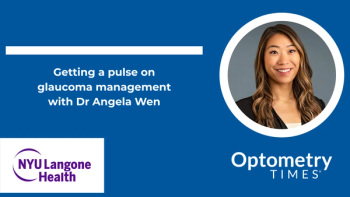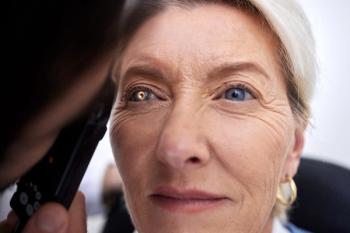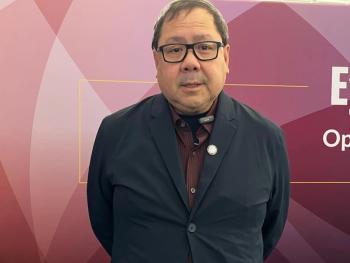
- May digital edition 2022
- Volume 14
- Issue 5
Glaucoma: More pressures than meet the eye
Other factors, besides IOP, can contribute to glaucomatous optic nerve damage
When considering
He explained that while the general principles for managing patients with glaucoma seem straightforward, i.e., the higher the IOP, the greater the risks are of bothglaucomatous damage and disease progression, other factors contribute to optic nerve damage and determine an individual’s susceptibility to damage from IOP. The current confounding factor is that there are no other effective treatments for glaucoma; lowering the IOP is the only avenue available.
Factors contributing to glaucoma
The scenarios of many patients are not straightforward. For example, Dr. Dunbar posed, some patients with high IOPs do not have glaucoma and have normal optic nerves with ocular hypertension; and the reverse is also true—a patient can have IOP in the normal range and the eyes have the appearance of severe glaucoma.
Other things that can show up in an examination are suspicious optic nerves seen on imaging or borderline high IOPs that leave the clinicians in a state of uncertainly about whether or not to begin treatment, he explained.
“Other factors besides IOP clearly contribute to glaucomatous optic nerve damage,” he emphasized and described as a representative case an 80-year-old woman with IOPs of about 12 mmHg and disc hemorrhages whose glaucoma was progressing.
Things to watch
Blood pressure. Investigators suggested 3 decades ago that systemic hypotension and decreases in the nocturnal blood pressure were instrumental in glaucoma progression. A combination of the lowest blood pressure levels at night and the highest IOP levels at night are risk factors for disease progression. “The combination of the 2 may result in a critical ocular perfusion pressure [OPP] in susceptible people, those with faulty autoregulation,” Dr. Dunbar commented.
OPP. OPP is defined as the relative pressure at which blood enters the eye, that is, the ocular arterial pressure minus the IOP. “OPP is a delicate balance between the OPP and blood pressure. Low OPP is a risk factor for progression resulting from low blood pressure and/or high IOP,” he said.
The reality of a relationship between OPP and glaucoma, however, has not been confirmed.
Dr. Dunbar explained that because OPP is difficult to measure, there is no widely accepted standardized method to evaluate blood flow and interpret the results. Currently, blood flow measurement are not used to diagnose or manage glaucoma.
Cerebrospinal fluid pressure. Two retrospective studies1,2 conducted by John Berdahl, MD, in 2008, included close to 100,000 patients that underwent a lumbar puncture. Of those who underwent an ocular examination, 217 had primary open-angle glaucoma (POAG). In the first study, the authors concluded that intracranial pressure was significantly lower in patients with POAG compared with controls without glaucoma; in the second study, the authors also concluded that the intracranial pressure was significantly lower in patients with POAG and normal tension glaucoma and the intracranial pressure was significantly higher in those with ocular hypertension.
“In the normal state, IOP and cerebrospinal fluid have minimal trans-laminar pressure difference. When the difference between the 2 is increased, the homeostatic balance and results in a pressure gradient difference at the lamina,” he explained.
What this seems to point to is compromised autoregulation, that is, the body’s inability to regulate itself in the presence of changes that include, vascular/postural changes, atmospheric pressure, temperature, fatigue, and resultant periods of ischemia that may occur and cause reduced or fluctuating IOP. “Autoregulation or vascular dysregulation can lead to over- or under perfusion, chronic underperfusion can lead to tissue necrosis or death, and unstable perfusion to oxidative stress,” he said.
These factors just point to the possibility that something other than the conventional IOP values may play a role in development of glaucoma.
The cumulative 20-year information gleaned from the all-important Ocular Hypertension Treatment Study indicated that about 30% of patients develop glaucoma over 20 years and various risk factors can increase that percentage significantly, i.e., older age, thinner cornea, and higher IOP. In addition, conversion to POAG occurs unilaterally. Finally, most patients with ocular hypertension eventually require treatment.
Dr. Dunbar concluded, “We recognize there are other factors besides IOP that influence the development/progression of glaucoma. We are gaining more and more understanding of these other factors--OPP, low blood pressure, and cerebrospinal fluid pressure. However, for now, the IOP is the factor that can be treated. The good news is that we have advanced technologies that can help us diagnose the disease earlier and detect progression earlier. And maybe, even 1 day soon, we will have a treatment that does not involve a drop, laser, or taking a medication.”
This article was adapted from Dr. Dunbar’s presentation at the SECO International conference, March 9-13, 2022, New Orleans. He is a consultant to and on the advisory board of Carl Zeiss, Allergan, Regeneron, and Genentech.
References
1. Berdahl JP, Allingham RR, Johnson DH.
2. Berdahl JP, Fautsch MP, Stinnett SS, Allingham RR. Intracranial pressure in primary open angle glaucoma, normal tension glaucoma, and ocular hypertension: A case control study. Invest Ophthalmol Vis Sci 2008;49:5412-8.
Articles in this issue
over 3 years ago
Water biology plays important role in healthover 3 years ago
2022 updates to ADA standards of care for patients with diabetesover 3 years ago
Phakic IOL implantation: Visual and refractive outcomesover 3 years ago
Compounded medications in ophthalmic patient careover 3 years ago
Expecting the unexpected in ocular casesover 3 years ago
What’s hot (and not) in retinal newsover 3 years ago
Navigating vision challenges in aviationalmost 4 years ago
Combatting dry eye during contact lens wearNewsletter
Want more insights like this? Subscribe to Optometry Times and get clinical pearls and practice tips delivered straight to your inbox.













































.png)


